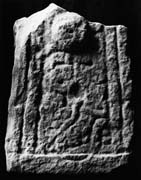Select a site alphabetically from the choices shown in the box below. Alternatively, browse sculptural examples using the Forward/Back buttons.
Chapters for this volume, along with copies of original in-text images, are available here.
Object type: Part of cross-shaft and -head
Measurements: H. 47.5 cm (18.7 in); W. 36 > 30 cm (14.2 > 11.8 in); D. 15.5 cm (6.1 in)
Stone type: Fine- to medium-grained, slightly feldspathic, very pale brown (10YR 7/3) sandstone; deltaic channel sandstone, Saltwick Formation, Aalenian, Middle Jurassic; from North Yorkshire Moors
Plate numbers in printed volume: 228-231
Corpus volume reference: Vol 3 p. 84-85
(There may be more views or larger images available for this item. Click on the thumbnail image to view.)
A (broad): A flat moulding extends along each edge and across the base. At each side an inner plain moulding, much worn and chipped, flanks a profile beast. Its rump and hind leg are at the bottom of the panel and its head hangs down on the left. It is fettered by a plain strand and the fore leg is tied to the curving neck at the top. The beast's head is damaged but is domed with a long snout closely associated with the fetters. There are random pellet fillers. Immediately above the animal, on the shaft, is a large domed boss.
The fracture has left a hint of a ring on the left-hand side.
B (narrow): The right-hand edge is lost. On the left is a flat edge moulding which turns across the base of the panel, though an incised line makes the horizontal band distinct. Within it is a vertical inner moulding, flat, with two bars formed by paired transverse incisions. Within that is a damaged strip with curled elements in regular registers: bars and pellets.
C (broad): Broken off.
D (narrow): The surface is much weathered, since it formed the exposed face when the stone was built into a wall. The lower part is plain. The outer moulding is very damaged but contains an inner one. Within is a worn run of indecipherable interlace, apparently using median-incised strands. It is interrupted at the top by a clipped off circular protuberance, probably the stump of the ring.
This cross fragment has close connections with pieces in the hinterland of York. The nearest parallel is North Frodingham 1 (Ills. 695–8), which has very similar treatment of the narrow sides where the interlace accommodates to the wheel. The prominent domed boss is placed in such a position as to suggest a cross with five such bosses: one in the centre and one on each arm corresponding with the line of the wheel. This too is a feature of North Frodingham 1; it is unusual elsewhere in the region but common in the Celtic west.
The fettered profile beast of the principal face is the only example of the Ryedale 'bound dragon' motif in the city of York itself. It should be compared with those at Sinnington (nos. 8–10), Kirkbymoorside (no. 1) and Middleton (nos. 1–2) (see Chap. 9). Perhaps this is a case of a provincial carver working for once in the city. The stone source may also be significant here: was the monument imported from Ryedale?
The short stumpy form is also unusual; it may have served as an end-stone adjacent to a recumbent monument. The monument has been recently analysed in detail by Tweddle (1987, 118–20).



